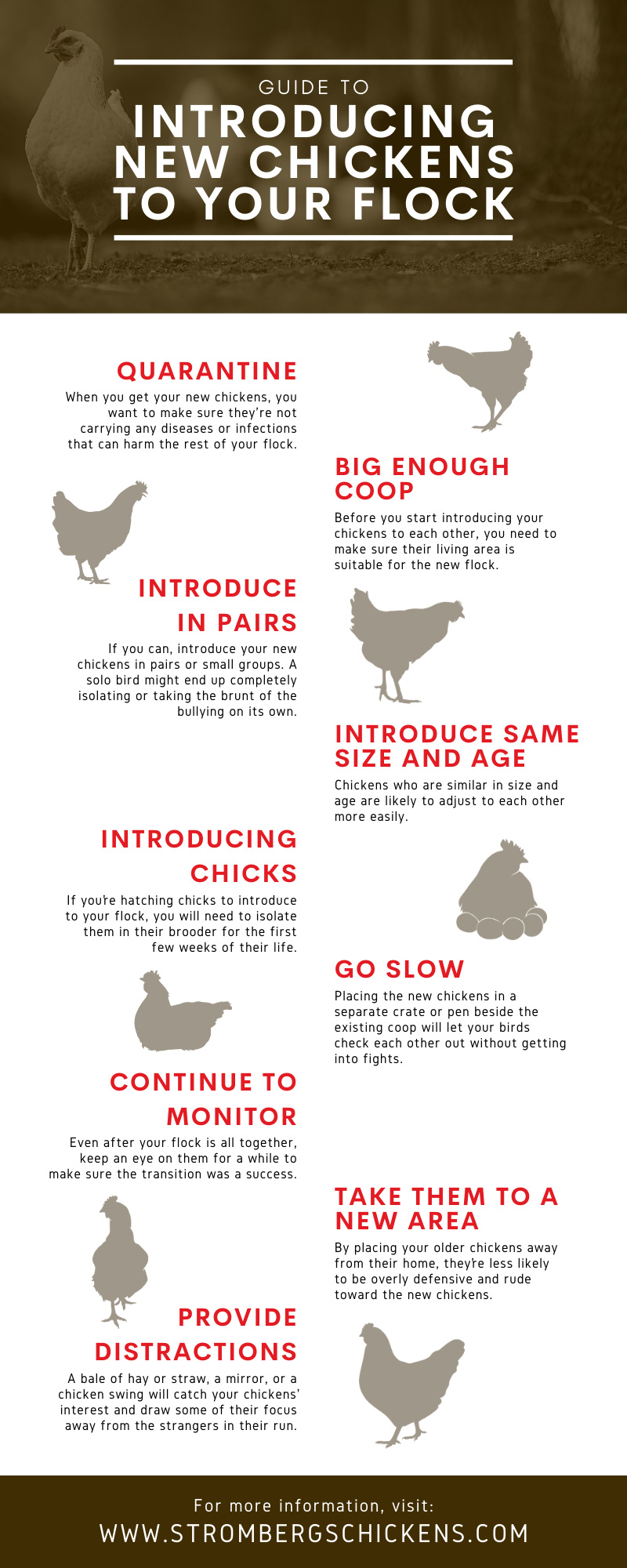Guide to Introducing New Chickens to Your Flock
From new spring chicks to adult birds who need a new home, many chicken farmers eventually introduce new birds to their existing flock. Unfortunately, this isn’t as easy as rearranging the space and letting them roam free together.
Chickens live according to an established pecking order, and new members can throw off the social hierarchy. To reduce the amount of chaos between new and old feathery little family members, check out this guide to introducing new chickens to your flock members.

QUARANTINE
When you get your new chickens, you want to make sure they’re not carrying any diseases or infections that can harm the rest of your established flock. This is especially important if you’re getting them as adults.
Quarantine the new birds in a separate space—a spare coop or cage works just fine. The important thing is that they’re not sharing space with the rest of the backyard flock. Make sure you wash your hands carefully between handling the new birds and the rest of the flock as well. Keep them apart for a couple of weeks at least.
The longer the quarantine, the more time you have to catch any signs of disease. This is also a good opportunity to make sure your new chickens are strong and healthy before meeting the rest of the backyard flock. This can help them out when it comes time to find their place in the pecking order.
BIG ENOUGH COOP
Before you start introducing your feathered friends to each other, you need to make sure their living area is suitable for the new flock. Depending on the number of birds you have and how many you’re getting, it might be time to get a bigger coop or run.
You can use an electric chicken fence to increase the size of your chicken’s range and make sure everyone has plenty of room to happily coexist. Be sure to expand the coop ahead of time so there are no extra squabbles due to overcrowding. Prepare a second roost if necessary so all your chickens have enough space.
Further, make sure that all your birds have access to plenty of chicken feed and water, even if other members of the established flock are domineering.
INTRODUCE IN PAIRS
If you can, introduce your new chickens in pairs or small groups. A solo bird might end up completely isolating or taking the brunt of the bullying on its own. However, if they have another new chicken beside them—especially one they’re compatible with—it can make the transition easier.
INTRODUCE SAME SIZE AND AGE
Chickens who are similar in size and age are likely to adjust to each other more easily. Pay attention to the traits of the chickens you’re planning to buy and try to find some who will fit in well with your existing flock.
Remember that smaller, weaker birds are far more likely to be the victim of bullying. However, if your new chickens are fitter, younger, and outnumber your older, more mature chickens, this can also bring a lot of stress to the flock.
It’s best to find and introduce chickens who are as similar to the rest of your flock as possible.
INTRODUCING CHICKS
If you’re hatching chicks to introduce to your flock, you will need to isolate them in their brooder for the first few weeks of their life. However, even after they’ve grown into young chickens, it’s important to keep them separate from the rest of the flock.
You want to wait until they’re old enough to defend themselves. Wait until your young birds are around 18 weeks old, eating layer feed rather than starter or grower feed, and the same size as the rest of the flock.
Then you can introduce them just as you would any other adult chickens.
GO SLOW
The most important step to introducing new chickens to your flock is to do it slowly. It’s a good idea to start by letting the birds see each other without actually interacting. Placing the new chickens in a separate crate or pen beside the existing coop will let your birds check each other out without getting into fights.
Once your healthy chickens have adjusted to each other’s presence, you can let them into the same space. Host this first interaction out in the yard or a run so they have plenty of space and can find some privacy if they need it.
After your flock has spent some time outside together, it’s time to move them all into the same coop. If you’re lucky, they will do this naturally after spending time in the range or run together. If not, you might have to place the new chickens into the coop yourself—preferably at night, when everyone’s settled down for the day.
CONTINUE TO MONITOR
Even after your flock is all together, keep an eye on them for a while to make sure the transition is a success. Pay special attention to your new birds and check for any harsh scratches or other injuries.
While squabbling is a natural part of bringing new birds into the flock, you want to interfere before it gets out of hand and harms your chickens. However, if your flock settles back into its daily routine, then congratulations! You successfully introduced new chickens to your flock.
OTHER TIPS
Every chicken and flock is different, which means it might take some trial and error before your chickens happily accept new members. If something doesn’t work, don’t be afraid to switch it up and try another method.
Here are a couple of other tricks that might make transitioning your flock a little easier.
TAKE THEM TO A NEW AREA
When it finally comes time to introduce the new and old birds, it’s a good idea to let them meet away from the coop. This might mean taking your old and new chickens to an entirely different area, such as a temporary coop or fenced-off part of the yard.
By placing your older chickens away from their home, they’re less likely to be overly defensive and rude toward the new chickens.
PROVIDE DISTRACTIONS
While you make sure your coop is large enough for new residents, outfit it with treats, distractions, and other tricks to minimize fuss and bullying. A bale of hay or straw, a mirror, or a chicken swing will catch your chickens’ interest and draw some of their focus away from the strangers in their run.
It’s also a good idea to provide a few safe places for the new chickens to get some privacy. Raised roosting bars or covered spaces offer a place for your chickens to retreat to.

What are some of your tried and true methods of introducing new chickens to your flock? We’d love to hear about them in the comments below!

